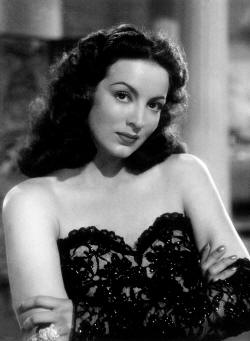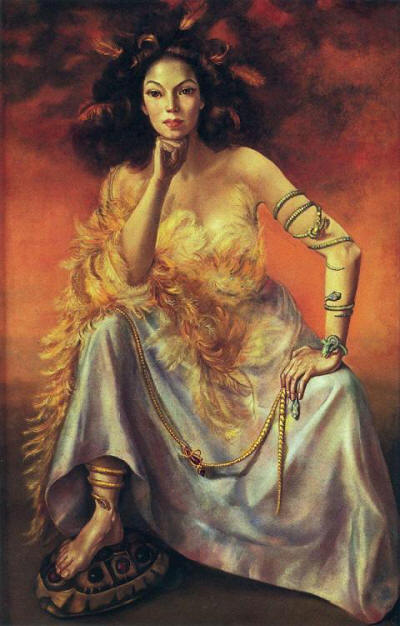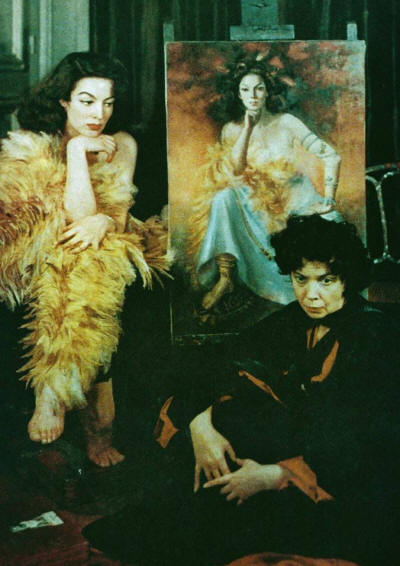

Queer Places:
Finca de Catipoato, Catipoato, Niño Jesús, 14080 Ciudad de México, CDMX, Mexico
Panteón Francés de San Joaquín
Miguel Hidalgo, Miguel Hidalgo Borough, Distrito Federal, Mexico
 María de los Ángeles Félix Güereña, known as María Félix (8 April 1914 – 8 April 2002), was a Mexican film actress and singer. Along with Pedro Armendáriz and
Dolores del Río, she was one of the most successful figures of Latin American cinema in the 1940s and 1950s. Considered one of the most beautiful actresses of Mexican cinema, her taste for the finesse and strong personality garnered her the title of diva early in her career.[3] She was known as La Doña, a name derived from her character in the film Doña Bárbara (1943), and María Bonita, thanks to the anthem composed exclusively for her, as a wedding gift by her second husband, the Mexican composer Agustín Lara. She completed a film career that included 47 films made in Mexico, Spain, France, Italy and Argentina.[4]
María de los Ángeles Félix Güereña, known as María Félix (8 April 1914 – 8 April 2002), was a Mexican film actress and singer. Along with Pedro Armendáriz and
Dolores del Río, she was one of the most successful figures of Latin American cinema in the 1940s and 1950s. Considered one of the most beautiful actresses of Mexican cinema, her taste for the finesse and strong personality garnered her the title of diva early in her career.[3] She was known as La Doña, a name derived from her character in the film Doña Bárbara (1943), and María Bonita, thanks to the anthem composed exclusively for her, as a wedding gift by her second husband, the Mexican composer Agustín Lara. She completed a film career that included 47 films made in Mexico, Spain, France, Italy and Argentina.[4]
During her stay in France, Félix was introduced by the painter Leonor Fini to French writer Jean Cau, assistant of the writer Jean Paul Sartre. Félix had a brief romance with Cau.[30] From the end of 1950 to the spring of 1954, Félix also had a passionate same-sex affair with Suzanne Baulé, better-known as Frede, who at the time ran the cabaret Le Carroll's on Rue de Ponthieu in Paris, and the two women lived together at the Hotel George-V. The relationship was captured in a painting made by Fini of a plant with two flowers; one had the face of Félix and the other Frede's.[31] Frede followed Félix on her filming trips to Buenos Aires and São Paulo upon learning of Félix's relationship with Carlos Thompson.[32] Félix and Frede's relationship was interrupted by Félix's marriage to Jorge Negrete, but upon Negrete's death in 1953, Félix returned to Paris to briefly rekindle her relationship with Frede. However, they would violently break-up for good in 1954, leading to a trial in which Félix wanted to take back jewellery she had given to Frede and accused her of theft. Félix lost her lawsuit, and Frede was acquitted and kept the jewellery.[31][32][33][34] Despite this, Félix held ownership of the painting Fini made of the two women, and afterwards Félix asked Fini to modify it to erase Frede's face, changing Frede's face to hers, resulting in the painting's two flowers both having Felix's face.[31][34]


.jpg)
Indicative of the relative freedom with which well-heeled homosexuals led their lives in Mexico City are the cases of the children of multimillionaire entrepreneurs and celebrities chronicled in society pages. Alberto Maus Santander, heir to a tobacco and real estate fortune, grew up in a progressive and cosmopolitan home. Born in 1925, he came of age in the 1940s, when prominent gays like Salvador Novo and Roberto Montenegro frequently visited his family. Alberto – known to everyone as Beto – dabbled in the arts and dreamed of studying abroad. In preparation, over the spring of 1960, he watched his figure and dieted, partaking only of steak and salad. Novo announced in his weekly column on 5 November 1960 that Beto planned to study interior decoration in Paris. Novo further noted ‘in fact, his family is to dine in the home of the young man who is to accompany Beto to Paris’. After his father’s death left him a substantial inheritance, Beto left the family home to install himself in a modern high-rise bachelor’s apartment on Insurgentes Avenue. Novo’s readers followed his move, his interest in interior design and learned of his talented cooking and entertaining.
Beto’s elegant eighth-floor apartment was two floors above that of his close friend and classmate Enrique Álvarez Félix, sole son of famed actress María Félix. ‘Quique’ to his friends, Álvarez Félix lived in a comfortable flat. It was ‘modern’, Novo noted, ‘but without the odd furniture that young people prefer’. Green velvet coverings on the sofas and chairs matched the green carpet and contrasted with the straw-coloured wallpaper. Many antiques, on loan from his mother’s Hacienda de Catipoato, softened the modern lines of the apartment’s finishings. Álvarez Félix frequently entertained at home with the help of his mother and her trusted confidante, the gay designer Armando Valdés Peza. Newspaper columns enumerated his guests, surreptitiously recording the unspoken intimacy of homosexual couples named among married heterosexual couples, as occurred in 1959, when Novo noted in his column that television producer Ernesto Alonso arrived with Angel Fernandez Vinas. Decades later, it was revealed that Alonso and Fernandez were lifelong companions, and had adopted two children whom they raised as their own, in an effort to construct an image of normalcy that would keep viewers of his television programmes from being scandalised by his homosexuality.
María Félix died in her sleep on 8 April 2002, her 88th birthday in Mexico City.[4] She was buried in her family's tomb alongside her son Enrique and her parents at Panteón Francés in Mexico City. In 2018, Google celebrated Felix's 104th birthday with a Google Doodle.[45]
My published books: